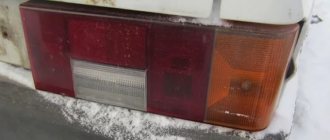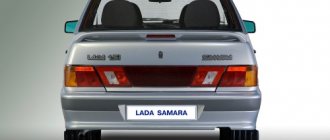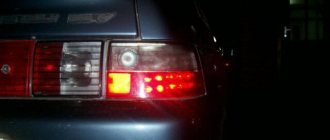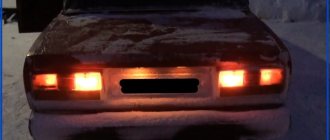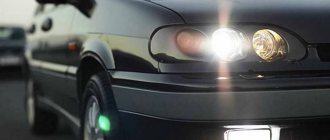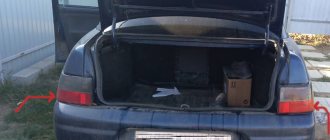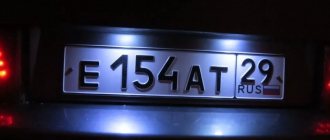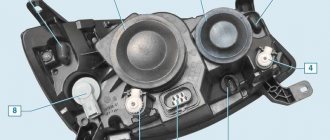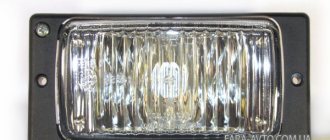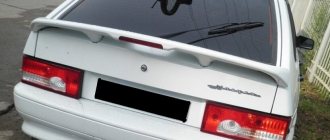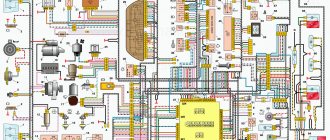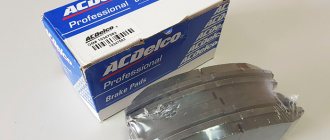The reasons for replacing rear lights on a VAZ 2110-2112 can be different and the main ones are the following:
- damage due to unsuccessful parking or an accident
- darkening and fading over time
This repair procedure is quite simple and you can do everything yourself, having only a few tools on hand, the list of which is given below:
- Phillips blade screwdriver
- Ratchet handle
- 8 mm head
- Extension
I think there is no need to explain once again that the rear lights are located in blocks, one of which is located in the wing, and the second in the trunk lid, so we will consider the removal procedure separately.
The device of the instrument panel on the VAZ 2110
The term “instrument panel” on cars refers to a block of warning lamps and indicators located in front of the driver. The correct name of the part is the shield, which is installed in a plastic panel called the dashboard.
The instrument panel on the VAZ 2110 includes:
- a device for determining the speed of movement - a speedometer;
- speed meter - tachometer;
- indicators of coolant temperature and fuel level in the tank;
- control indicator lamps equipped with yellow, orange, green, blue and red filters;
- lighting system (6 separate lamps);
- installation location of the warning lamp.
On VAZ 2110 cars it is possible to see several options for instrument combinations:
- The first releases used an electromechanical version of the panel with serial number 2110-3801010. Externally, the device is easily identified by a mechanical odometer mounted on the speedometer scale. Its drive is made from an electric motor, the rest of the indicators operate on a magnetic principle. On the back of the shield there are two connection blocks located at right angles.
- Later, an electronic version of the dashboard appeared, equipped with a liquid crystal display on the bottom of the speedometer. There are “gauges” with a “suction” indicator (which was not installed on the VAZ 2110 with such a panel from the factory) or with an airbag lamp in the same place. There may be cars with a double display window - under the tachometer and speedometer.
- A very rare variant of the instrument cluster is designed for the VAZ 21106, equipped with a 2.0-liter Opel engine. The part number is 21106-3801010 and features an extended speed measurement range (up to 240 km/h) and an additional liquid crystal display on the bottom of the tachometer.
- On the latest versions of the VAZ 2110, a shield began to be used, unified with the 2118 Kalina car (model 1118-3801010), differing in the layout of the scales. Such a part is called a “new sample” panel among its owners. The device is installed in a modified type dashboard.
“New” electronic panel
Old style electronic panel
Electromechanical panel
Shield for Opel engine
Depending on the manufacturer and date of assembly, there are different designs for the VAZ-2110 instrument clusters. It is possible to digitize the tachometer in hundreds or thousands of revolutions, write technical information on the scale, etc.
Diagram of injection VAZ 2110 16 valves
CLICK HERE (TO SEE THE VAZ 2110 ELECTRICAL WIRING DIAGRAM IN HIGH RESOLUTION)
| 1 – block headlight | 2 – front brake pad wear sensor | 3 – fan motor activation sensor |
| 4 – electric motor of the engine cooling system fan | 5 – sound signal | 6 – generator |
| 7 – oil level sensor | 8 – carburetor solenoid valve control unit | 9 – heater controller |
| 10 – recirculation valve switch | 11 – backlight lamp for heater control levers | 12 – switch |
| 13 – carburetor limit switch | 14 – oil pressure warning lamp sensor | 15 – spark plugs |
| 16 – carburetor solenoid valve | 17 – coolant temperature indicator sensor | 18 – ignition distributor |
| 19 – ignition coil | 20 – starter | 21 – heater fan electric motor |
| 22 – additional resistor of the heater electric motor | 23 – speed sensor | 24 – reverse light switch |
| 25 – micromotor gearbox for heater damper drive | 26 – recirculation valve | 27 – brake fluid level sensor |
| 28 – blocks for connecting the rear window washer motor | 29 – battery | 30 – windshield washer motor |
| 31 – washer fluid level sensor | 32 – coolant level sensor | 33 – windshield wiper motor |
| 34 – mounting block | 35 – blocks for connecting the warning light harness | 36 – external lighting switch |
| 37 – instrument cluster | 38 – rear fog light switch | 39 – fog light indicator lamp |
| 40 – indicator lamp for heated rear window | 41 – hours | 42 – rear window heating switch |
| 43 – steering column switch | 44 – block for switching wires when installing headlights of another type | 45 – instrument lighting switch |
| 46 – ignition switch | 47 – blocks for connecting the wiring harness for headlight cleaners | 48 – socket for a portable lamp |
| 49 – directional lamp | 50 – brake light switch | 51 – interior lamp |
| 52 – on-board control system unit | 53 – fuel level indicator sensor | 54 – hazard warning switch |
| 55 – driver’s seat belt sensor | 56 – cigarette lighter | 57 – ashtray illumination lamp |
| 58 – glove compartment lamp switch | 59 – block for connecting the on-board computer | 60 – glove box lighting lamp |
| 61 – side turn signal | 62 – switch in the front door pillar | 63 – switch in the rear door pillar |
| 64 – parking brake warning lamp switch | 65 – trunk light | 66 – cabin air temperature sensor |
| 67 – external rear light | 68 – internal rear light | 69 – license plate light |
| 70 – block for connecting the rear window heating element | 71 – block for connecting an additional brake signal |
Why VAZ-2112 headlights do not work and repairs
On VAZ-2112 model vehicles, left and right headlights are mounted on the front. This design combines both low and high beam. Manufacturers can be Bosch or Avtosvet, respectively, and the products have minor differences. However, the mounts are always located in the same places, which allows you to easily install headlights made in different factories. The light bulbs used are also absolutely identical. Their characteristic feature is the presence of only one filament coil. What to do if for some reason the headlights installed on the VAZ-2112 do not work? We'll talk about this further.
Additional block
It is located under the center console and is covered with a lid. One part is accessible from the right side.
- 15A - Ignition module, controller
- 15A - Canister purge valve, vehicle speed sensor, oxygen concentration sensor (heating), air flow sensor
- 15A - fuel pump, fuel pump fuse, injectors
- Electric fan relay
- Fuel pump relay
- Main relay (ignition relay)
On our channel we also prepared a video on this publication. Watch and subscribe.
The dashboard on the VAZ 2112 and turn signals stopped working |
If your windshield wipers or windshield washer do not work, check this relay. Also check the wiper motor, washer pump and washer fluid level in the washer reservoir.
Expert opinion
It-Technology, Electrical power and electronics specialist
Ask questions to the “Specialist for modernization of energy generation systems”
Fuse box VAZ 21124 16 valves europanel. Fuses and relays VAZ 2110 / 2111 / 2112 If your turn signals or emergency lights do not work, check this relay and fuse F16, as well as the turn signal lamps themselves and their switch. Ask, I'm in touch!
Both headlights do not work
In the case when two headlights fail at once (and both the high and low beams do not work), the switch responsible for the external lighting is first inspected. It is easy to test the circuit using a test light or a regular tester. One wire is applied to ground, and the other to the 30th terminal. If this is not the problem, then there will be 12 volts on it (even with the ignition off). After turning the key, voltage will also flow to terminal 10. Such diagnostic results allow us to say with complete confidence that the light does not come on precisely because of the switch.
If there is no voltage at the terminals mentioned above, then most likely the wires have broken or the contact has been lost.
TROUBLESHOOTING AND THEIR REMOVAL (REAR AND FRONT DIMENSIONS)
Now we just have to figure out why such problems occur and how to solve them, for example, how to replace a side lamp on a VAZ 2114 in any part of the car. So, first of all, let’s figure out why the lights don’t light up and what reasons there could be for this:
- No voltage on headlights;
- The lamps are burnt out;
- The fuse has blown;
- The fuse box has failed;
- The button to turn on the lights is broken.
So, now we need to understand each specific option in more detail, for example, why the left rear light does not light up. The first and most logical reason is that the lamp simply expired and burned out, just as happens with ordinary household light bulbs. Now it needs to be replaced; this is done in the same way in all parts of the car:
- First you need to find where the headlight housing or collar housing is located from the inside and remove the protective cover; on the VAZ 2114 it is clearly written on it how this is done. Everything will come out together with the base;
- Now you need to find the size in the base and carefully pull it out;
- We take out the lamp, it is simply inserted here with a latch;
- We insert the new one so that it clicks and assemble everything in the reverse order.
As for the fuses, if the rear right indicator light does not light, then in order to do without special tools and diagnose the cause, you just need to replace the suspicious fuse with a new one and see if the situation improves. If the lamps light up, then it was the problem, but if not, then you will have to look for the cause further. The tail light is always off. A very weak point is a design flaw in the contact group in the headlight.
To understand why the rear lights on a VAZ 2114 don’t light up, you need to look at the car’s electrical circuit; power to the lights goes along with the headlights, and if they don’t light up only at the front or rear, then it’s the wiring. It will have to be checked, but without the special knowledge of an electrician, it is unlikely that you will be able to find an open circuit or some other reason on your own. But if the right indicator light on a VAZ 2114 or only the left one does not light up, then it’s all a matter of fuses, replacing them is simple - take out the old ones and insert new ones in the same place. Checking the button is also quite simple - you need to remove it from the panel and short-circuit the wires; if the lamps light up, then it’s the problem. You will need to find a new button that will fit there and install it.
Rear lights on VAZ 2114 do not light up
When both side light bulbs on one side of a car, left or right, fail, the reason is always clear. The fact is that the safety block contains one fuse responsible for each side. It is necessary to replace the corresponding fuse and the problem will be eliminated.
At the same time, there is a constant discussion on the Internet on forums about whether the front lights on a VAZ 2114 don’t light up or why the rear lights on a VAZ 2114 don’t light up. Quite a lot of opinions and different experiences are expressed. If we summarize all this, we can draw the following conclusions.
The side lights of the rear hemisphere are located in the rear light block, in which a generally recognized disease is constant oxidation and corrosion of the contact groups. For preventive purposes, it is necessary to constantly monitor this board.
The same is possible on the contacts of the front headlights. Nevertheless, from practice there are cases when, when checking the performance of light bulbs, it turned out that they burned out on both sides at the same time (maybe one by one, but the driver did not notice this in time). At the same time, the amateur master checks everything, just not the light bulbs, claiming that the probability of simultaneous failure of the lamps is absolutely minimal. But auto electricians first check the lamp and contact.
Like all not new cars that have been removed from the production line a long time ago, second-generation Samaras are subject to minor breakdowns over the years, which, among other things, affect lighting devices. For this reason, many drivers are faced with the fact that the rear lights on their VAZ 2114 do not light up, which can lead to dangerous situations on the road if the problem is not solved in time.
Detailed diagrams of important components of the VAZ 2110 car
If you need an exact diagram of any component of your car, then I recommend that you familiarize yourself with these diagrams.
Generator system connection diagram
| 1 – battery | 2 – generator | 3 – mounting block |
| 4 – ignition switch | 5 – battery charge indicator lamp, located in the instrument cluster |
VAZ 2110 starter connection
| 1 – battery | 2 – generator | 3 – starter |
| 4 – ignition switch |
Diagram of the ignition system on the VAZ 2110
- Installation on VAZ 2108 and 2109 with a low torpedo instrument cluster from 2115
| 1 – battery | 2 – ignition switch | 3 – ignition relay |
| 4 – spark plugs | 5 – ignition module | 6 – controller |
| 7 – crankshaft position sensor | 8 – master disk | A – matching devices |
Contactless ignition system diagram
| 1 – ignition coil | 2 – ignition distributor sensor | 3 – spark plugs |
| 4 – switch | 5 – ignition switch |
Turning on the rear window wiper and washer
| 1 – washer motor | 2 – mounting block | 3 – ignition switch |
| 4 – rear window wiper and washer switch | 5 – rear window wiper gear motor | K6 – additional relay |
| A – to power supplies | B – the order of conditional numbering of plugs in the gear motor block |
Diagram of the automatic heater control system
| 1 – fan motor | 2 – additional resistor | 3 – controller |
| 4 – mounting block | 5 – ignition switch | 6 – cabin air temperature sensor |
| 7 – recirculation switch | 8 – recirculation valve | 9 – micromotor gearbox for heater damper drive |
| A – to the instrument lighting switch | B – to power supplies |
The rear lights on the VAZ 2110 do not light up, what could be the problem? In this article we will look at the main types of faults in the electrical equipment of this car, and at the same time we will learn how to replace the rear marker lamps of a VAZ 2110.
Contents: 1. Connection diagram 2. Typical faults and their elimination 3. What kind of light bulbs are there 4. Replacing the size lamp 5. Where to look for the fuse
Causes
The side lights can be turned on either with the ignition off or on. In the event that at least one side light bulb does not light, relay K1, located in the mounting block, will turn on a warning light on the instrument panel to warn the driver about this malfunction.
In this case, the driver, with the side lights on, needs to get out of the car and see which of the four lamps is not on. If all the size lamps are on, then you also need to check the brake light lamps, since relay K1 is also activated for these lamps, and if at least one of them burns out, the warning lamp on the instrument panel will light up. After all, brake lights also ensure traffic safety.
The electrical circuit of the side lights is protected by two fuses. F11 (5A), works on the side lamps on the starboard side, and F1(5A), on the starboard lamps, it also protects:
- license plate lamps;
- instrument panel lighting lamps;
- side light indicator lamp;
- trunk light lamp.
Therefore, if fuse F1 blows, troubleshooting will have to be done in all of the above electrical circuits.
If all the side light lamps do not light up, then first of all you need to check the Ш2 connector block in the mounting block (it is located horizontally), since it is through contact No. 7 of this plug connector that power is supplied to the side light lamps. A possible reason for the dimensions not turning on could be the three-position switch located on the front panel. The serviceability of the switch can be checked by ringing it with a tester and, if necessary, replaced.
Causes of breakdowns
There can be many reasons for malfunctions. The most common problem is that the lamps burn out, which naturally makes it impossible to turn on the side lights. Lamps brought to us from the Middle Kingdom are especially unreliable in this regard.
Although they are attractive at a more than “democratic” price, and there are plenty of them at any retail outlet, you won’t be able to get away with them. Therefore, perhaps we should remember the saying that we are not such rich people as to buy cheap things twice.
Good branded light bulbs will last many times longer, and you won’t have to change them endlessly.
Lamp options for dimensions
Sometimes there is a “flashing” of the dimensions, or the blinking of the instrument panel lighting when the side lights are turned on. Many blame the size relay for this, but they cannot find it. In the carburetor VAZ 2110 there is no size relay, there is only a relay for high and low beam.
For a fuel-injected car, the relay should be found in the mounting block, where all the fuses are located. Moreover, if the relays burn one after another, you should immediately contact electrical specialists, because this indicates that there is a short circuit somewhere in the circuit, and from here it is not far from the burnt-out car.
Mounting block and relays and fuses
Never, under any circumstances, should a blown fuse be replaced with a more powerful one, or even with a “bug”.
This material will help you choose an alternative low beam lamp: https://vazweb.ru/desyatka/osveshchenie/lampa-blizhnego-sveta.html
As already said, it is prohibited to drive a car in the evening or at night if the side lights are not on, so we will look for the cause and then eliminate it.
If you are sure that the paths through which electricity passes are in good condition, the first thing to do is check to see if the lamps have burned out. And if they need a replacement, do it.
For the head lamp, the replacement procedure is as follows:
- Open the hood;
- We disconnect the battery, or even better, remove it. After all, we are talking about electricity, which is unsafe;
- From the engine compartment, holding the lamp with your hand, disconnect the wires directly going to the light bulb from the block;
- Remove the rubber cover;
- We move the latch to the side, disengaging the spring from the hook;
- We take out the size bulb;
- We replace it with a new one and put everything back together.
When the replacement is made, we check whether the head lamps are on.
Light bulbs in the rear dimensions on a VAZ 2110 are installed as follows:
- We de-energize the car;
- From the trunk (open) side, remove the contact part of the rear light with lamps. To do this, you need to release the latches;
- Remove the headlight bulb and replace it with a new one.
Do not forget that you cannot touch the halogen lamp with your bare hands. Replacement must be done with gloves. The fact is that dark spots will appear where you touch the light bulb. In addition, it has been proven that such a light bulb burns out much faster.
Why the low and high beams on the VAZ 2110 do not work
To figure out why the low and high beam headlights on a VAZ-2110 car do not work, you need to know what you need to pay attention to when trying to fix this problem. These cars are equipped with a headlight unit where the direction indicators are located, as well as two options for high and low beam headlights
These options differ in that in one case there are two single-filament lamps in the headlight unit (separately for the low beam headlights and separately for the high beam), and in the other case there is one, two-filament lamp. Therefore, there are two plugs in the electrical wiring for connecting the corresponding set of headlights.
Also involved in the operation of the electrical circuit of external lighting are: the external lighting switch, which is located in the cabin on the front panel; The headlight switch is located on the steering column; The low beam relay, the high beam relay and 4 fuses are located in the mounting block, and the high beam warning lamp is located on the instrument panel. When the high beams are turned on, all 4 filaments in the exterior lighting lamps should light up.
If one or more threads of the headlight lamps do not light, then, without getting out of the car, check the integrity of the fuses located in the mounting block under numbers F2, F3, F12, F13. Fuse F2 protects the low beam filament in the left headlight, F3 protects the high beam filament in the left headlight, F12 protects the low beam filament in the right headlight, F13 protects the high beam filament in the right headlight and the high beam indicator lamp.
Provided that the fuses are intact and their contacts are not oxidized, you will have to get out of the car, open the hood and check the serviceability of the corresponding lamps, those that do not light up. It's not difficult to do this. You just need to remove the rear casing, disconnect the wire block, remove the spring securing the light bulb in the headlight and pull out the light bulb holder by turning it counterclockwise. We replace the burnt-out lamp with a similar new one.
If the fuses and lamps are intact and undamaged, then we check the two relays indicated on the electrical diagram as K4 and K5. Their possible malfunctions will be oxidation or burning of the contacts, which can be eliminated by cleaning them. If the relays fail completely, you will have to install serviceable ones instead.
After making sure that all of the above devices are in working order, you will have to check the reliability of the connection in the blocks included in the electrical circuit of the headlights and the fastening of the headlights' ground wires. One ground fastener is located on the left, next to the battery on the air intake mount. Second from the right, in the place where the adsorber is located. If this does not help, you will have to remove the headlight switch and the exterior lighting switch one by one and check the condition of the contacts in them.
The most common lighting problems in the VAZ-2112
All faults that arise are divided into two categories:
- mechanical;
- electric.
During vehicle operation, external lighting devices are exposed to various negative influences. They are often rendered unusable:
- stones flying out from under the wheels of cars driving in front;
- sand;
- branches of bushes, etc.
Thus, the first thing to do if you were unable to turn on the headlights is to check their integrity. The simplest option in this case is to replace the entire unit that has become unusable. Removing it is not difficult. In addition, the headlight can be repaired
It is important to pay attention to restoring its tightness - ignoring this requirement leads to rapid failure of the entire unit, since moisture that gets inside contributes to:
- constant fogging of lenses;
- oxidation of contacts;
- rapid wear of fasteners.
The most common electrical failure is a light bulb burnout - this is usually indicated by the failure of only one of the headlights. There are no special options here - you will have to change it to a working one.
If the lamps are good, then you should suspect the following faults:
- the fuse link has burned out;
- the electromagnetic switching relay has deteriorated;
- one of the circuit contacts has come off (or oxidized);
- there is a break in the wires;
- there is no mass.
What should you know about car optics?
A modern car has a large number of lighting fixtures.
All of them are combined into a single lighting system that performs the following functions:
- illuminates the road and side of the road;
- signals the driver's intentions;
- informs about the dimensions of the car;
- illuminates the interior, engine compartment, luggage compartment, etc.
All devices are divided into external and internal lighting. The external ones include front headlights, turn signals, side lights, rear lights, license plate lights, fog lights on the VAZ 2112. The headlights on the VAZ 2112 are a block that contains several lighting devices: low and high beam lamps, side lights, DRL.
Turning and side lights are signaling lights. The former warn about the driver’s intentions to perform a particular maneuver, the latter inform about the vehicle’s dimensions. They are built into the front headlight and rear lights. A special feature of signaling devices is that they shine yellow and synchronously.
Requirements for installing daytime running lights on cars have appeared recently. They have an intense light, their function is to improve the visibility of the car when driving in the daytime. In their absence, this function is performed by low beam or PTF. Fog lights on the VAZ 2112 are designed for driving during bad weather when visibility is poor. They are installed in pairs at the front. The back may be missing.
The rear lights of the VAZ 2112, like the headlights, are block headlights. These include the exterior light, turn lights and side lights.
Tail lights VAZ 2111
The rear optics include a brake light, a luggage compartment light and a license plate light.
Interior lighting consists of: interior lights, engine compartment lights, door lights, trunk lights, glove compartment lights, and dashboard lights.
Features of choice
Automotive optics is constantly evolving and at this stage the following types can be named:
Halogen lamps resemble conventional incandescent lamps in their design: a glass bulb contains electrodes with a tungsten filament. Due to the high heating temperature, halogen lamps quickly fail as the tungsten filament burns out. The main advantage of these lamps is their low cost.
Xenon lamps shine much brighter than halogen lamps. At the same time, they do not have a filament, so they are not afraid of shocks and vibrations. Xenon is durable and economical. The disadvantage is that both bulbs have to be changed, since during operation the brightness decreases, so the light of the lamps will be different. In addition, xenon optics require the installation of an ignition unit.
LED optics have bright light, economical energy consumption, long service life, and do not heat up. Another advantage is the ability to install LEDs of different colors. The disadvantage is low efficiency. For high-quality lighting you need a large number of LEDs (video author - Pro Sport).
Laser optics uses laser LEDs, which are characterized by high power and small size; their light is very bright. The disadvantage of laser lighting elements is the complexity of control.
When choosing optics, you should be guided by the following factors:
When choosing lamps, you need to take into account the parameters (base type, markings, etc.) that are indicated in the instruction manual. You cannot install xenon on a VAZ 2112 in halogen optics
When installing xenon, it is necessary to change the optics to the appropriate lens. You should pay attention to the manufacturer and buy lighting fixtures from well-known companies. The seller should ask for a certificate stating that the product can be used in European countries.
Lighting must meet the requirements.
Troubleshooting methods
What are the troubleshooting options:
- If there is no backlight, you need to check the fuse and replace it if it is blown. All failed light bulbs must be replaced.
- If the sensors are not working, you should check the integrity of the wiring with a multimeter or other tester to check the wiring. Damaged sections of wires also need to be replaced.
- If the car interior is humid, over time this can lead to oxidation of the shield contacts. If such a malfunction occurs, the contacts must be cleaned or replaced.
- If the problem lies precisely in the inoperability of the instrument cluster, then it is better to entrust the repair to specialists. It is possible that in the process you will have to resolder some elements, so if you do not have experience in carrying out such events, then contact an electrician (the video was shot by Alexey Lipatov).
Instructions for dismantling the tidy
So, how to remove and disassemble the device for its subsequent repair or replacement:
To begin, you will need to use a Phillips screwdriver to unscrew the two self-tapping screws located on the top trim. After this, you also need to unscrew two more bolts, they are located on the bottom of the lining. Then you need to carefully detach the cover and put it aside. Next, the connectors with wiring from the buttons located on the sides of the device are disconnected. This will allow you to move the trim to the side. Only after these steps can you unscrew the two bolts that secure the tidy to the center console
They are located at the ends. Then you need to carefully slide the combination back, parallel to disconnecting it from the metal plates installed on top. For complete dismantling, you also need to disconnect the two connectors with the wiring on the back of the panel. Having done this, you can remove the device from the mounting location and begin repairing or replacing it. The assembly procedure is carried out in reverse order.
Replacing the headlight bulb
Replacing the size lamp in the rear lights of a VAZ 2110 is quite simple. First of all, we dismantle the board with the lamps in the same way as we did when troubleshooting: we bend the upholstery flap, squeeze the two latches and remove the board from the lamp (see above). In this case, the power supply does not need to be disconnected - the length of the wires is quite enough to replace light bulbs. Before us are three lamps - one small and two large. We need the first one.
The side light bulb in the rear light is the smallest
We press it down slightly and, turning it counterclockwise, remove it from the socket. In place of the burnt one, we install a new one, also drowning and turning, but clockwise. Turn on the side light and check the result of the work. If everything is in order, we install the board in place, making sure that both latches work, and close the canopy with the upholstery flap.
Device
The head lamps (front dimensions) are part of the headlight unit. Rear dimensions are part of the rear light of the VAZ 2110, being one of its sections. Nearby there is a rear fog lamp, a taillight, a turn signal, a reflector, a brake signal and a marker.
Fog lights will not only improve the appearance of your car, but will also improve safety. You can read about connecting fog lights here: https://vazweb.ru/desyatka/osveshchenie/kak-podklyuchit-protivotumanki.html
Ideas for tuning and modifying the shield
As for tuning, you have several options for improving the shield:
- The easiest option is to put a new trim on top of the tidy. This method is the easiest to implement, but it will improve the external part of the tidy, because you just glue the trim on top. If the existing trim is worn out and has damage, it can be re-sheathed.
- New scales can be installed on the sensors - speedometer, tachometer, fuel and antifreeze. You can purchase such overlays either in a store or download them from the Internet. If you want the scales to be original, you can make them yourself using a graphic editor. Tuning is more complicated, since you will need to not only dismantle the device itself, but also partially disassemble it and disconnect the arrows from the indicators. Moreover, subsequently the arrows themselves must be installed correctly, otherwise the sensors may not work correctly.
- You can also install an instrument panel from a Lada Priora car in the “Ten”. In general, these devices are suitable for installation in the “Ten”, but depending on the design features of the car, it may be necessary to redo some connectors. If you decide to connect an electronic device, you may have to additionally reflash the control unit.
- One of the most effective and simple improvement options is to install LED lamps in a combination. To do this, you will need to remove the standard lighting sources and simply install LEDs instead. To make the tidy shine more brightly, you can install an LED strip instead of light bulbs, in which case it will have to be soldered to the combination. If the lamp burns out, it will be enough to replace it. In the case of tape, everything is more complicated - it will have to be desoldered and soldered again, although it usually has a long service life.
- Additionally, when installing diode light sources, instrument scales can be painted with fluorescent paint. You can also paint the controller arrows. The essence of this tuning is that by combining LED lighting with the coloring of the hands and scales, you can achieve a fairly colorful and effective result. Especially if you combine the colors correctly. For example, white and blue LED lighting combines perfectly with bright green or red instrument scales.
Instrument panel device
What to do if the tidy stops working? How to diagnose and repair the shield, how to disassemble the device correctly? To begin with, we recommend that you familiarize yourself with the features of the device.
This unit includes the following components:
- Tachometer or speed sensor. With its help, the control unit reads the number of crankshaft revolutions.
- Speedometer or speed sensor. Everyone knows what it is needed for - to demonstrate the speed of the car.
- , allowing you to determine the remaining displacement of gasoline in the gas tank.
- Antifreeze temperature sensor, which is also an internal combustion engine temperature controller. Thanks to it, the driver can know when the engine has warmed up to operating temperature and when the power unit is overheating.
- The device also includes indicators indicating whether electrical equipment is turned on or not working. A total of twelve indicator lights should be used.
- To enable the driver to use the instrument at night, the dashboard is equipped with backlight bulbs.
- The devices are equipped with an econometer - a fuel economy sensor that shows in which driving mode gas savings will be optimal. The same panels also use electrical circuit voltage sensors, according to which it is possible to detect the voltage level in the electrical network - undercharge or overdischarge.
- There is also an additional, backup connector in the device. Indicators of additional equipment that were not installed by the manufacturer are connected to it. For example, these could be airbags, fog lights, etc.
- On the back of the device there are connectors for connecting wiring.
To prevent you from confusing the pads during repairs or diagnostics, each of them is marked with a specific color.
For example, the red block, in accordance with the diagram, is marked as X2, and the white block is marked as X1. Domestic “Tens” can be equipped with different devices, in this case it all depends on the configuration and year of manufacture of the car.
The VAZ 2110 can use old or new devices:
- A distinctive feature of the old-style tidy is the installation of all sensors and indicators symmetrically.
- As for the new type of devices, the coolant temperature controllers, as well as the fuel level controllers, began to be located with a slight shift to the right. In addition, the new devices no longer use a voltage controller in the car network, as well as an econometer.
Diagram of injection VAZ 2110 8 valves
CLICK HERE (TO SEE THE VAZ 2110 ELECTRICAL WIRING DIAGRAM IN HIGH RESOLUTION)
| 1 – block headlight | 2 – front brake pad wear sensors | 3 – sound signal |
| 4 – cooling system fan | 5 – reverse light switch | 6 – battery |
| 7 – generator | 8 – oil pressure warning lamp sensor | 9 – oil level sensor |
| 10 – spark plugs | 11 – nozzles | 12 – idle speed regulator |
| 13 – electronic control unit blocks | 14 – throttle position sensor | 15 – crankshaft position sensor |
| 16 – ignition module | 17 – coolant temperature indicator sensor (for instrument cluster) | 18 – starter |
| 19 – diagnostic block | 20 – coolant temperature sensor (for engine management system) | 21 – speed sensor |
| 22 – fuel pump activation relay | 23, 35, 39 – fuses | 24 – electric fuel pump |
| 25 – micromotor gearbox for heater damper drive | 26 – recirculation valve | 27 – heater fan |
| 28 – windshield washer pump | 29 – washer fluid level sensor | 30 – brake fluid level sensor |
| 31 – coolant level sensor | 32 – windshield wiper gear motor | 33 – additional heater fan resistor |
| 34 – injection system power supply relay | 36 – adsorber purge valve | 37 – mass air flow sensor |
| 38 – relay for turning on the cooling fan | 40 – external lighting switch | 41 – knock sensor VAZ-2110 injector |
| 43 – fog light indicator lamp | 44 – indicator lamp for heated rear window | |
| 45 – fog light switch | 46 – rear window heating switch | 47 – instrument cluster |
| 48 – mounting block | 49 – fuel level sensor | 50 – ignition switch |
| 51 – instrument backlight brightness control | 52 – steering column switch | 53 – backlight lamp for heater control levers |
| 54 – hazard warning switch | 55 – electronic heater control unit; | 56 – recirculation valve switch |
| 57 – display unit of the on-board control system | 58 – side direction indicators | 59 – temperature sensor for the heating system |
| 60 – interior lamp | 61 – front interior lamp | 62 – socket for a portable lamp |
| 63 – electronic watch | 64 – switches in the front door pillars | 65 – switches in the rear door pillars |
| 66 – glove box lighting lamp | 67 – glove box lighting switch | 68 – cigarette lighter |
| 69 – ashtray lighting lamp | 70 – brake light switch | 71 – rear window heating element |
| 72 – external rear lights | 73 – internal rear lights | 74 – license plate lamps |
| 75 – trunk lighting lamp |
Tips for motorists
According to these Rules of the Road, on any moving vehicle, including the VAZ-2114, the headlights must be turned on, along with which the side lights must also be turned on. In addition, they must be turned on when the car is stopped or parked on the road in the dark and in conditions of insufficient visibility. Therefore, they must always be in good working order.
The electrical circuit of the side lights of the VAZ-2114 is not so complicated and, if desired, any self-respecting driver will be able to find a malfunction associated with the failure of its operation. To do this, you need to know that terminal No. 1 of the side light switch is always supplied with positive voltage from the battery, bypassing the ignition switch. If the side light switch key is in the on position, then electric current flows to two fuses F10 (7.5A) and F11 (7.5A), which respectively protect the electrical circuits of the left (F10) and right (F11) side lights. The further path of the current lies to relay K4 (lamp health monitoring relay), and then to the front and rear side lamps.
When only one of the side light bulbs does not light, then we check whether it has burnt out. If it burns out, then we replace it with a new one of similar power, but if it is intact, then we will have to look at the condition of the contacts of the cartridge in which it is inserted. In the rear lights, due to moisture getting into them, oxidation is possible, both of the tracks and the pads through which voltage is transmitted to the terminals of the side light lamp.
Another reason why the headlight lamp does not light up may be the lack of voltage at the corresponding terminals of the rear light blocks or headlight blocks. Then, using a tester, you will have to ring the corresponding wires:
- The right front marker does not light up (check the yellow wire from terminal No. 4 of the headlight to terminal No. 8, block X6 of the mounting block);
- The right rear light does not light up (check the yellow wire from the right rear light block to terminal No. 9, block X9 of the mounting block);
- the left front marker does not light up (check the yellow-black wire from terminal No. 4 of the headlight to terminal No. 10, block X6 of the mounting block);
- the left rear light does not light up (check the yellow-black wire from the right rear light block to terminal No. 17, block X9 of the mounting block);
If both lamps on the right or left side of the car stop working, then troubleshooting should begin by checking the corresponding fuses located in the mounting block under the hood of the VAZ-2114 car, since the simultaneous burnout of two dimensional lamps at once is unlikely. The blowing of fuse F10 is very easy to determine, since it will lead to the cessation of combustion of the backlight lamps of the instrument switches. Also, the reason for turning off the side lamps may be the failure of relay K4.
3 comments
When you press the brake pedal, the rear turn signals turn on. When you turn on the turn signals, the rear lights begin to switch and shine like garlands?
When connecting to the board in the chip (connector), the wires were not connected correctly. And the chip itself is apparently not original, but was attached by someone illiterately, despite the diagrams. You have the wire that is responsible for the turns - in place of the dimensions. It is easy to treat. You need to transfer the wires from the wiring to the chip. You need to find the ground on the rear stopper board (there is a green stripe on the board that runs under each light bulb socket); see which wire is connected through the chip and connect to the black wire from the rear wiring. Then we take the wire on the chip below and connect it in the following sequence: 1 wire in the chip with black (ground), 2 - blue (turn signal), 3 - red (stopak), 4 - yellow (marker)
On the right side, the dimensions do not light up, the fuses are intact, and the light bulbs are intact. Could it be K4?
Connection diagram
Before we start troubleshooting, let's look at the connection diagram for external lighting devices on the VAZ 2110.
Electrical diagram of external lighting devices on the VAZ 2110
The numbers on the diagram indicate:
How does this scheme work? After turning on the external light switch 3, the voltage from the battery is supplied to the mounting block 2, then through fuses F1, F11 and the control relay it is supplied to the side lamps. In this case, F1 is responsible for the left side of the car (side), F11 for the right. Relay K1 turns on the warning light on the instrument panel if any of the side light lamps stops lighting.
Important! In some modifications of the VAZ 2110, instead of the K1 control relay, jumpers are installed, indicated by arrows on the relay diagram.
